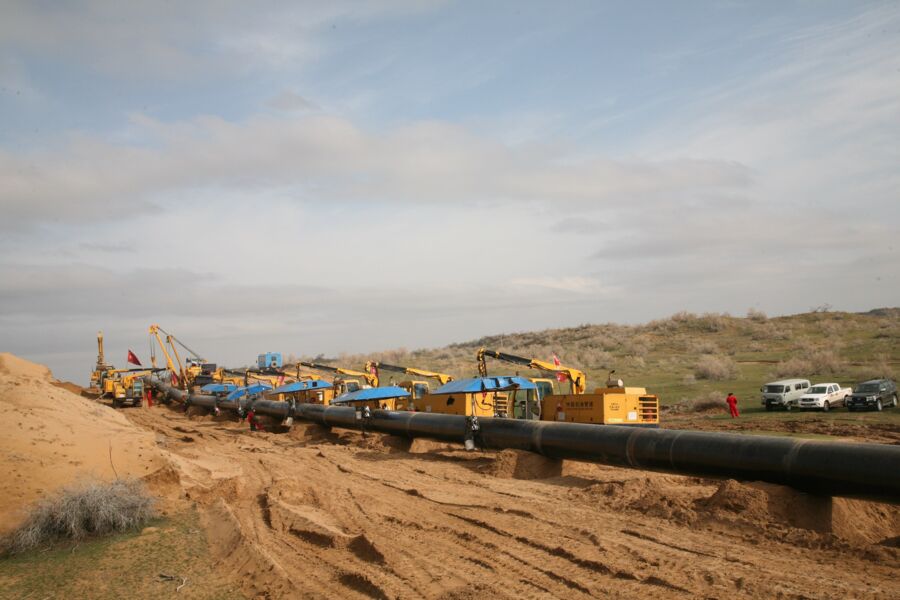At its peak, Russia’s energy relationship with Europe generated massive returns for state-owned Gazprom. Before 2022, Russia supplied as much as 40% of Europe’s gas imports. The Russian giant that even leveraged Turkmenistan’s reserves to pump higher volumes westwards.
Now, Central Asia could turn into a consumer of Russian gas.
Осы мақаланың қазақша нұсқасын оқыңыз.
Читайте этот материал на русском.
Since the start of Russia’s full-scale invasion of Ukraine, the former European partners have gradually distanced themselves from Russian energy supplies and imposed sanctions on a number of entities and individuals.
On January 1 this year, Russia’s transit agreement with Ukraine expired, essentially shutting the main Europe-bound gas pipelines for the first time in four decades. Now, Russia only accounts for 11% of European gas demand, including LNG.
The move, a response to Ukraine’s refusal to renegotiate contract terms, has left Gazprom scrambling for alternative buyers.
“Russia is sitting on enormous gas reserves,” said Vitaly Yermakov, a senior research fellow at the Oxford Institute of Energy Studies (OIES).
“Gazprom now has a choice to either let some of its largest fields deplete by halting investments into their management, or find alternative markets,” Yermakov told Vlast in an interview.
After doubling exports last year, Central Asia could be Russia’s obvious choice, according to experts.
Jack Sharples, a senior research fellow at the OIES focusing on Russian and European gas markets, argued that this would inevitably translate into more modest profits.
“Central Asia is an attractive prospect, to the extent that the region as a whole is not self-sufficient and faces a deficit in supply that Gazprom could meet. The challenge for Gazprom is that those markets are not as lucrative as the European markets they lost,” Sharples told Vlast.
From the flip side, Central Asia will likely gain from the new changes in the Eurasian gas market, according to Francesco Sassi, a postdoctoral fellow at the University of Oslo.
“The Central Asian gas market is quite isolated, between two poles, Russia and China. So, the impact of the global changes in the gas industry has been less visible, although natural gas still plays a key role in stabilizing regional energy security and to support the long journey towards energy transition,” Sassi told Vlast.
New Energy Realities in Central Asia
In the 1970s and 1980s, the massive Central Asia-Center pipeline pumped gas from Turkmenistan via Uzbekistan and Kazakhstan towards Russia, a typical supply chain direction within the Soviet economy. Raw materials and food followed a centripetal pull from the “periphery” to the more industrialized and populated “center”. From Kazakh oil and Turkmen natural gas, to Uzbek canned fish and Kyrgyz wool, most of Central Asia’s production was directed to Russia’s industrial hubs.
After the fall of the Soviet Union, Turkmen gas continued to flow through the CAC pipeline, the only export outlet for the country, until significant Chinese investment in the country’s largest fields led to the construction of a China-bound pipeline in 2009. This allowed Turkmenistan to weigh its options with Russia and negotiate better contract terms.
Gas exports to Russia fell to around 11 billion cubic meters (bcm) in the years following the opening of the China-bound pipeline, only to be slashed to just 3.1 bcm in 2015. In the meantime, exports to China grew to around 40 bcm annually. Trade relations with Russia soured with gas exports being halted for long periods, until a new contract was struck in 2019 for 5.5 bcm.
After Russia’s war in Ukraine started in 2022 and European customers gradually disengaged from Russian gas, the idea of mixing Turkmen gas into Russia’s westbound pipelines became redundant. After failing to negotiate mutually beneficial terms, the two parties let the contract expire last summer.
“The annual supply that Turkmenistan agreed to pump to Russia in 2019 expired in 2024. Turkmenistan does not enjoy short-term supply agreements, yet that was a Gazprom coup, showing up as a trusted customer during a time of hardship,” Sassi argued.
And the same could be said for Gazprom’s role in supplying gas to Central Asia. With Europe no longer being a viable option, Gazprom might look at Central Asia as an alternative, despite lower market prices.
According to Bloomberg, Gazprom could lose up to $6 billion in annual export revenue after stopping gas transit to Europe. This would also translate into diminished budget revenues for Russia’s coffers.
Experts believe that it would be impossible for Russia to reap the same benefits as with Europe, because of the heavily subsidized gas markets in Central Asia.
“For now, Gazprom simply needs to take what it can get in terms of securing sales volumes. Gazprom may hope that at some point they can increase exports to Europe again, but I would suggest that in the near term, say the next two years, it remains unlikely,” Sharples argued.
“It’s better to sell some gas for a smaller profit margin, than to sell no gas,” Yermakov quipped.
The New Normal
In 2024, Kazakhstan produced 59.2 bcm of gas, a 6.4% increase compared to 2023. Analysts, however, focus on another number: Commercial gas production. Most of the gas produced at Kazakhstan’s largest oil and gas fields is in fact reinjected into the ground to help with oil extraction. The figure of commercial gas production in 2024 is much lower, standing at around 29 bcm. The vast majority of the gas produced (21.2 bcm) were consumed internally.
According to Qazaqgaz, the maximum hourly consumption of natural gas in Kazakhstan increased by 6.3% to 3.4 million cubic meters last year. The average daily gas consumption also increased by 5%.
While domestic consumption increases, exports are falling at a breakneck pace. In 2024, Kazakhstan’s exports shrank by 40% to 8.7 bcm. Karachaganak, Kazakhstan’s biggest single gas producer, exported 62% less gas to Russia and 8% less gas to China compared to 2023.
Perhaps counterintuitively, Kazakhstan is also a key importer of gas, due to Soviet-era infrastructure linking some of its northern cities with fields in Russia. In 2024, imports from Russia fell by 22% to 6.6 bcm, while Kazakhstan continued to import marginal volumes from Turkmenistan.
In Uzbekistan, natural gas production has been in decline for more than a decade, with output shrinking by 30% between 2010-2023. Uzbekneftegaz, the state-owned industry giant, plans to produce 26.5 bcm of commercial gas in 2025, an 18% reduction compared to 2022.
From gas exports being a major source of hard currency, Uzbekistan has recently banned exports and instead signed deals to import gas to meet its growing domestic needs. In October 2023, by reorienting the gas flow in the CAC pipeline, Uzbekistan started importing Russian gas.
“Uzbekistan treats its gas deficit as a national security problem. It’s not by chance that it asked Gazprom for supplies and entered talks with Kazakhstan and Turkmenistan,” Sassi said.
Both Kazakhstan and Uzbekistan want to bet on natural gas for their energy mix, but found themselves in need for more than what they can produce. Relying on coal has become increasingly frowned upon–despite strong coal lobbies, especially in Kazakhstan–and a much advertised “green transition” is still far from complete.
Given the existing trade deals, both countries could maintain the relationship with Russia in the long term.
“Central Asian countries are great customers for Gazprom and they don’t seem interested in disengaging anytime soon. This relationship pits the perspective of economic growth against a potential political influence,” Sassi said.
And both Kazakhstan and Uzbekistan seemed to worry precisely about political influence when Russia proposed a so-called “Gas Union” in 2022.
The proposal from Moscow was met with cold shoulders in both Astana and Tashkent.
In December 2022, Uzbekistan’s energy minister went as far as to say that his government “will never agree to political conditions in exchange for gas.”
The Russian government could focus on leveraging either prices or influence, according to Sharples. Yet, the diverse geopolitical landscape could produce mixed results.
“The Russian government could compel Gazprom to offer the gas at a cheaper price, but then it could seek to extract some kind of political concession from the country it’s selling to. And because of the diverse nature of Russia’s relations with each country in Central Asia, there would be a question of what concessions it would ask from each one,” Sharples said.
Both Central Asia, with its energy deficit, and Russia, with more gas supply than wealthy customers, need a partnership. The question is now about what each side’s negotiating tactics will produce.
Ongoing sanctions have swayed Russia’s commercial interests towards China, with growing plans for the Power of Siberia gas connection, and Central Asia, which does not need additional infrastructure, just industrial coordination.
Asked whether the situation with Europe could be appeased and Gazprom would reorient its exports again soon, Sharples remained skeptical.
“There are many practical, legal, and commercial obstacles that would have to be overcome for Gazprom to rebound its exports to the European market, and even if those obstacles were overcome, the process would not be quick and, by the time they would be overcome, the European market could be a lot more competitive, because we are going to be in the middle of the big new wave of LNG supply,” Sharples said.
With few alternatives left, Gazprom may have to settle for the most viable option.
“In the near term, for Gazprom, sales to Central Asia are what is available. And these volumes could still be important even in the late 2020s,” Sharples concluded.
Поддержите журналистику, которой доверяют.









